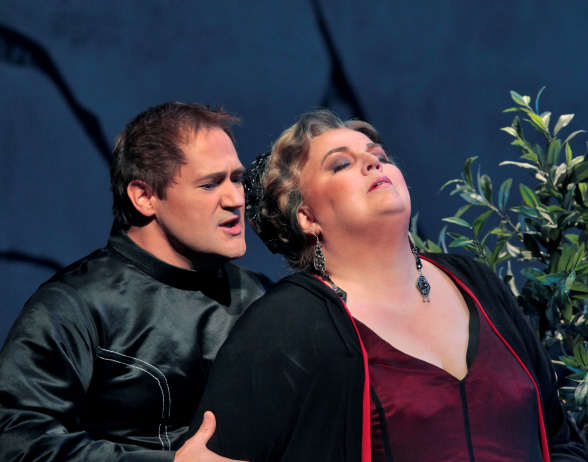Other Links
Editorial Board
-
Editor - Bill Kenny
-
Deputy Editor - Bob Briggs
Founder - Len Mullenger
Google Site Search
SEEN AND HEARD INTERNATIONAL OPERA REVIEW
Gluck, Alceste:Soloists, Chorus and Orchestra of Santa Fe Opera,
Kenneth Montgomery (conductor), Santa Fe, USA, 19.8.2009 (RH)
Having seen three different productions of Gluck's 'Alceste' in my 30 years of opera going, I do not regard Gluck's 'Alceste' as unusual. But talking to audience members at Santa Fe Opera,
it seemed that this opera was quite new to them.
It is in this light that Francisco Negrin's production musit be viewed. Negrin and designer Louis Desire created a world with its own logic which was, however, far removed from the story's classical origins but seemed intended to help the newcomer to understand the
plot.
Director: Francisco Negrin
Choreographer: Ana Yepes
Design: Louis Desire
Lighting Design: Duane Schuler
Cast:
Herald - Nicholas Pallesen
Coryphee - Jennifer Forni
Evandre - Aaron Blake
Alceste - Christine Brewer
High Priest - Nicholas Pallesen
Oracle - Tom Corbeil
Admete - Paul Groves
Hercule - Wayne Tigges
The Infernal God - Tom Corbeil
Apollo - Matthew Morris

Admete - Paul Groves and
Alceste - Christine Brewer
As with Gluck's other mature operas, in 'Alceste' there is no sub-plot. Instead the composer uses the chorus and a semi-chorus of soloists to provide dramatic and musical contrasts. Negrin's handling of the chorus, all dark clad and sombre, was admirable. At Santa Fe the chorus members are young singers on the company's apprentice scheme. In 'Alceste' they made an admirable clear, flexible sound. The singers responded to Negrin's direction to create a characterful backsdrop to the principals. Thus far, thus traditional.
But it was in his handling of the Gods that Negrin showed his distinctive ideas. The Gods and their attendants (played by dancers choreographed by Ana Yepes) were clad in costumes and masks that mixed Mexican 'day of the dead' with science fiction. The gods were ubiquitous and once Alceste (Christine Brewer) had made her vow she was shadowed by the Infernal God (Tom Corbeil) right to the end of the opera.
Personally I would have liked a greater element of neo-classical beauty in the depiction of the Gods. But taken on its own terms, Negrin and Desire's highly coloured concept worked:
except for moments like Alceste's 'Divinites du Styx' when Brewer's sublime Alceste had to cope with a backdrop of dancing demons.
I can think of few dramatic sopranos today who could sing the taxing role of Alceste with the beauty of line and cleanness of tone that Brewer brought to it. It is perhaps significant that Brewer has studied with Birgit Nilson, herself a notable Alceste. Brewer sang with a gleaming beauty of tone and flexibility of line. She always sang within the music and never needed to distort for effect Gluck's 'beautiful simplicity'.
Brewer's Alceste was dignified and noble of bearing, but highly expressive. Gluck's music allows the singer to express her love and tenderness for husband and children. Alceste is a far warmer role than Leonora in 'Fidelio' and Brewer expressed this warmth.
Her performances of the role's great arias were notable, but Brewer was supremely moving in the role's quiet moments at the gates of Hell in Act 3. She may be a dramatic soprano with Isolde and Brünnhilde in her repertoire, but in Act 3 she displayed some profoundly beautiful, high quiet singing.
Brewer was ably supported by Paul Groves as Admete, the husband whom she rescues by volunteering to go to her death in his stead.
Groves, who recorded the role 10 years ago under John Eliot Gardiner, was a notably virile Admete. Sometimes he pushed the tone a little too far
but with the role's high tessitura, he avoided the tendency some tenors have of sounding perpetually surprised.
He and Brewer created a believable and moving interaction. One of the production's real strengths was that, despite the science fiction elements, Negrin enabled you to believe in Alceste and Admete as real people.
We attended a preview talk which gave some background to both the opera and Negrin's production. Without this I am not sure that some of Negrin's ideas would have been clear. He introduced an older couple, intended to be Admete's parents, who refused to give up their lives for
their son's.
Then at the end, in the final celebratory ballet, Negrin had death slowly
taking away each successive generation, indicating that ultimately all die.
Interesting ideas, but how much could have been understood without prior
briefing, I wonder?
The young singers in the smaller roles were admirably cast with Jennifer Forni (Coryphée), Aaron Blake (Evandre) and Nicholas Pallesen (Herald, High Priest) contributing strongly. A special mention must be given to Tom Corbeil who not only sang the oracle, but incarnated the infernal god with all the compelling flexibility of a dancer.
Wayne Tigges sang the small but important role of Hercule, who rescues Alceste from death. Tigges had the physique to look a creditable strong man
and Matthew Morris was a truly scary looking Apollo.
Choreographer Ana Yepes (who also danced in the production) has trained in both modern and baroque dance.
Her choreography spanned both worlds, but never overwhelmed the late baroque idiom of the music.
Conductor Kenneth Montgomery kept things moving whilst allowing the music to flow, it never felt driven. But playing a late baroque score on modern instruments, Montgomery seemed to feel obliged to keep the orchestra reined in. So there were moments, notably during 'Divintes du Styx' when I could have wished for more power from the brass.
Gluck's dignified scores are not easy to stage. Santa Fe Opera made a notable attempt with their first 'Alceste', a production rendered all the more powerful by Christine Brewer's incarnation of the title role.
Robert Hugill
Picture © Ken Howard
